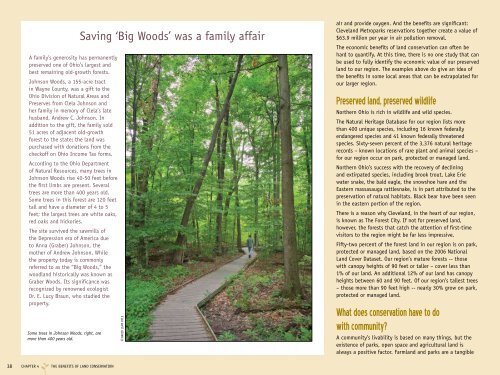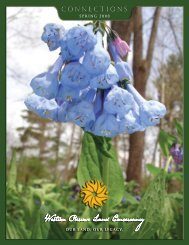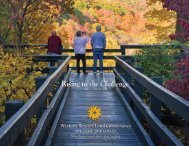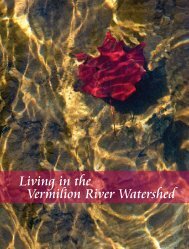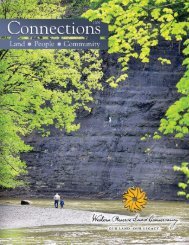Common Ground - Western Reserve Land Conservancy
Common Ground - Western Reserve Land Conservancy
Common Ground - Western Reserve Land Conservancy
Create successful ePaper yourself
Turn your PDF publications into a flip-book with our unique Google optimized e-Paper software.
A family’s generosity has permanently<br />
preserved one of Ohio’s largest and<br />
best remaining old-growth forests.<br />
Johnson Woods, a 155-acre tract<br />
in Wayne County, was a gift to the<br />
Ohio Division of Natural Areas and<br />
Preserves from Clela Johnson and<br />
her family in memory of Clela’s late<br />
husband, Andrew C. Johnson. In<br />
addition to the gift, the family sold<br />
51 acres of adjacent old-growth<br />
forest to the state; the land was<br />
purchased with donations from the<br />
checkoff on Ohio Income Tax forms.<br />
According to the Ohio Department<br />
of Natural Resources, many trees in<br />
Johnson Woods rise 40-50 feet before<br />
the first limbs are present. Several<br />
trees are more than 400 years old.<br />
Some trees in this forest are 120 feet<br />
tall and have a diameter of 4 to 5<br />
feet; the largest trees are white oaks,<br />
red oaks and hickories.<br />
The site survived the sawmills of<br />
the Depression era of America due<br />
to Anna (Graber) Johnson, the<br />
mother of Andrew Johnson. While<br />
the property today is commonly<br />
referred to as the “Big Woods,” the<br />
woodland historically was known as<br />
Graber Woods. Its significance was<br />
recognized by renowned ecologist<br />
Dr. E. Lucy Braun, who studied the<br />
property.<br />
Some trees in Johnson Woods, right, are<br />
more than 400 years old.<br />
38 CHAPTER 4 THE BENEFITS OF LAND CONSERVATION<br />
Saving ‘Big Woods’ was a family affair<br />
© DAVID LIAM KYLE<br />
air and provide oxygen. And the benefits are significant:<br />
Cleveland Metroparks reservations together create a value of<br />
$63.9 million per year in air pollution removal.<br />
The economic benefits of land conservation can often be<br />
hard to quantify. At this time, there is no one study that can<br />
be used to fully identify the economic value of our preserved<br />
land to our region. The examples above do give an idea of<br />
the benefits in some local areas that can be extrapolated for<br />
our larger region.<br />
Preserved land, preserved wildlife<br />
Northern Ohio is rich in wildlife and wild species.<br />
The Natural Heritage Database for our region lists more<br />
than 400 unique species, including 16 known federally<br />
endangered species and 41 known federally threatened<br />
species. Sixty-seven percent of the 3,376 natural heritage<br />
records – known locations of rare plant and animal species –<br />
for our region occur on park, protected or managed land.<br />
Northern Ohio’s success with the recovery of declining<br />
and extirpated species, including brook trout, Lake Erie<br />
water snake, the bald eagle, the snowshoe hare and the<br />
Eastern massasauga rattlesnake, is in part attributed to the<br />
preservation of natural habitats. Black bear have been seen<br />
in the eastern portion of the region.<br />
There is a reason why Cleveland, in the heart of our region,<br />
is known as The Forest City. If not for preserved land,<br />
however, the forests that catch the attention of first-time<br />
visitors to the region might be far less impressive.<br />
Fifty-two percent of the forest land in our region is on park,<br />
protected or managed land, based on the 2006 National<br />
<strong>Land</strong> Cover Dataset. Our region’s mature forests -- those<br />
with canopy heights of 90 feet or taller – cover less than<br />
1% of our land. An additional 12% of our land has canopy<br />
heights between 60 and 90 feet. Of our region’s tallest trees<br />
– those more than 90 feet high -- nearly 30% grow on park,<br />
protected or managed land.<br />
What does conservation have to do<br />
with community?<br />
A community’s livability is based on many things, but the<br />
existence of parks, open space and agricultural land is<br />
always a positive factor. Farmland and parks are a tangible


